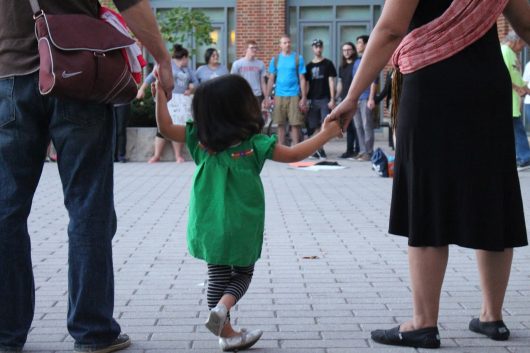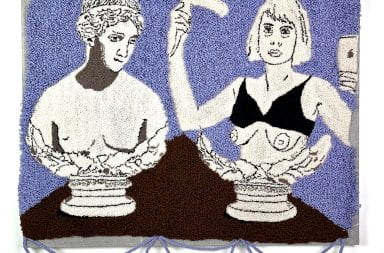
Protestors from North Dakota to Ohio are using the phrase “Water is life,” in their opposition to the construction of the Dakota Access Pipeline. Credit: Mitch Hooper | Engagement Editor
About 100 activists, students, faculty members and members of Native American tribes from all over the nation convened outside the Ohio Union Thursday evening to join in solidarity for those protesting against the construction of the Dakota Access Pipeline at the Standing Rock Sioux Reservation in North Dakota.
The rally, which was hosted and organized by Ohio State’s Native American and Indigenous Peoples Cohort, aimed to bring awareness to the cause and collect donations to send to the Sacred Stone Camp, where many are camped out to in an effort to stop the development of the crude-oil pipeline. Protesters say the pipeline would go through land considered sacred by Native Americans and disturb water access.
Raymond Roach, of the Cheyenne River Sioux tribe, which is located just an hour south of Standing Rock Reservation, has lived in Columbus for many years and is considered the community elder by many in Columbus’ Native American diaspora, those in attendance said.
He led the event from the center of a circle formed by those attending the rally, where a traditional Native American drum lay, with chairs for tribe members to sit in surrounding it. Throughout the two-and-a-half hour rally, he guided the crowd of about a hundred people in traditional songs of prayer. Before the event was over, Roach performed a smudging ceremony on the entire group, asking everyone to get in a large circle and hold hands. The ceremony requires a burning stick of sage to pass over one’s body to cleanse and remove negative energy.

Those attending the rally gather in a circle in front of the Ohio Union on Sept. 15. Credit: Elizabeth Suarez | Multimedia Editor
While there was an area for donations of money, supplies and food, prayer was emphasized by many members of the community who spoke as the most important approach to stopping the pipeline from being built.
Madison Eagle, a graduate student in the school of social work who identifies as Shawnee and Cherokee, helped plan the event, and said she was not surprised by the turnout.
“I’m really proud that we could bring so many people to this one spot and come together and pray and send up good thoughts to the Creator and fill this space with such good energy,” Eagle said.
Some in attendance called out or displayed on their signs the phrase, “Mni Wiconi”, which in the Lakota language translates to “Water is life.”
Kathy Begay, of the Navajo Nation, located in northwestern New Mexico, plans to travel to the Sacred Stone camp with her family and bring supplies and funds that she and her family gathered.
“We can’t sit back and watch this planet — mother Earth — be destroyed anymore. It’s not a Sioux Nation problem, it is a human race problem. If we keep letting these multi-billion dollar corporations come in and dictate what are future children or grandchildren will be living in, then they will have nothing left,” Begay said.
Other groups not directly connected to the cause also attended to show solidarity Thursday evening.
“We as Palestinians know what it feels like to have our land stolen from us and destroyed. This is why Palestinians stand next to the Native Americans, next to the African-American people of this country because we know far too well what it feels like in our own country,” said Reema Jallaq, a Columbus resident who is Palestinian-American.
Some in attendance also wore Black Lives Matter t-shirts to display solidarity with the Native cause.
Eagle referenced the Tyre King vigil, which occurred on the South Oval just before the #noDAPL rally, saying that she appreciates the support from the Black Lives Matter community.
“I’m really proud to say that we stand with Black Lives Matter, and Native Lives Matter. That’s what’s going to create change,” said Eagle.


